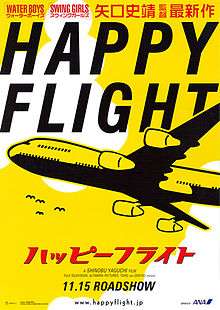Happy Flight
Happy Flight (ハッピーフライト, Happī Furaito) is a Japanese comedy film directed by Shinobu Yaguchi about pilots and flight attendants. All Nippon Airways (ANA) backed the creation of the film. The airline sponsored a giveaway of Happy Flight DVDs and other items to certain members of ANA's mileage club.[1]
| Happy Flight | |
|---|---|
 Film poster | |
| Directed by | Shinobu Yaguchi |
| Produced by | Shintaro Horikawa, Daisuke Sekiguchi |
| Written by | Shinobu Yaguchi, Junko Yaguchi |
| Distributed by | Toho |
Release date | November 15, 2008 |
Running time | 102 min |
| Country | Japan |
| Language | Japanese |
Story
The film Happy Flight is about Kazuhiro Suzuki, a copilot who is trying to qualify as a pilot, and Etsuko Saitō, a young flight attendant going on her first international flight, who service an All Nippon Airways 747-400 as Flight 1980 to Honolulu, Hawaii, United States. Suzuki feels stressed when Captain Noriyoshi Harada becomes his evaluator, while Saitō becomes stressed when she learns she is working under Chief Purser Reiko Yamazaki. The story also tells the story of Natsumi Kimura, a ground staffer who deals with issues regarding the flight.
The plot revolves around the logistics of preparing Flight 1980 for a timely departure. The aircraft serving has been reported with malfunctioning heated pitot tubes, but the captain decides to postpone the repair to avoid delays, relying on redundant instruments available. Bird patrol has been dispatched to fend off pigeons. Immediately after takeoff, an instrument alarm prompts the captain in command to switch to the backup pitot tube as their primary indication. The captain mistakenly transmits the cabin announcement to the air traffic channel.
Inflight services commence shortly after the seat belt sign has been turned off. Due to the overbooked flight, not all passengers could receive their first choice of lunch between beef and fish; the cabin purser gives her stewardess a lesson in dealing with demand imbalance: promoting the less wanted fish. The stewardess follows through with her first mishap, describing the beef as "plain and ordinary." She then fumbles orders for white wine, apple juice, and motion sickness drugs. She corrects the drink orders; but the ill passenger vomits onto her uniform.
Up in the cockpit, the checking copilot responds to passenger worries by visually checking the wings over a bird-strike related incident. Meanwhile, the plane behaves erratically under the captain's solo command. Ground staff has confirmed that the flight suffered a bird strike; the engines ingested a bird without failing; but the bird also disabled the remaining pitot tubes, freezing the plane at cruising altitude. The aircraft has lost all indication of air speed until they descend to below 22,000 feet, where air temperature is above freezing point.
With the aircraft unable to complete the journey, the captain elects to return to Haneda airport, now suffering from severe weather conditions. The flight crew and ground controllers then have to work together to take the plane back home, win the cooperation of a "difficult" passenger, fly around adverse weather, and determine if the maintenance crew was at fault for the aircraft's failure.
Cast
- Haruka Ayase (Etsuko Saitō (斎藤 悦子, Saitō Etsuko))
- Tomoko Tabata (Natsumi Kimura (木村,菜採, Kimura Natsumi))
- Seiichi Tanabe (Kazuhiro Suzuki (鈴木 和博, Suzuki Kazuhiro))
- Shinobu Terajima (Reiko Yamazaki (山崎 麗子, Yamazaki Reiko))
- Saburō Tokitō (Noriyoshi Harada (原田 典嘉, Harada Noriyoshi))
- Kazue Fukiishi
- Ittoku Kishibe
Reception
Mark Schilling of The Japan Times reviewed the film, giving it three of five stars. Schilling said that he "felt somewhat like a convict watching a prison film whose heroes are the trustees and guards — and feeling the filmmakers aren't getting the whole story."[1]
References
- Schilling, Mark. "Airplane flick tells only half the story." The Japan Times. Friday November 14, 2008. Retrieved on February 19, 2010.